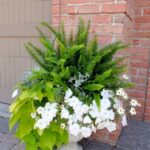Are you looking for vegetable garden design ideas for small gardens? Having a vegetable garden, even in a limited space, has numerous benefits. From providing fresh produce to promoting a healthier lifestyle, gardening in small spaces can be both rewarding and practical. However, thoughtful design is essential when it comes to maximizing a small area for vegetable cultivation.
In this article, we will explore the importance of having a vegetable garden in a small space and the significance of thoughtful design. We will discuss how to assess your available space and consider factors such as sunlight, soil quality, and access to water.
Additionally, we will delve into various design ideas and techniques for vertical gardening, container gardening, companion planting, raised beds, and maximizing space. Whether you have a balcony or a tiny backyard, there are plenty of creative ways to cultivate your own vegetables.
With the right knowledge and inspiration, anyone can create a flourishing vegetable garden in even the smallest of spaces. So whether you’re an urban dweller or simply working with limited outdoor space, this article will provide you with the valuable information and ideas needed to get started on your own small vegetable garden design. Let’s turn that limited space into a thriving oasis of fresh produce.
Assessing Your Space
When it comes to designing a vegetable garden in a small space, the first step is to assess the available area for gardening. Whether you have a tiny backyard, a balcony, or just a few square feet of land, it’s important to make the most of the space you have. Consider the amount of sunlight your garden receives, as most vegetables require at least six hours of direct sunlight each day.
Additionally, pay attention to soil quality and access to water. You may need to amend your soil or consider using raised beds or containers if your soil is not ideal for growing vegetables. Adequate access to water is also crucial for successful vegetable gardening.
The key to successful vegetable garden design ideas for small gardens lies in making use of vertical space. Vertical gardening allows you to grow plants upward instead of outward, maximizing every inch of available space. Consider installing trellises, hanging baskets, or wall-mounted planters to grow vining vegetables such as tomatoes, cucumbers, and beans.
Additionally, utilizing shelving units or tiered plant stands can provide additional growing space for herbs and leafy greens. By thinking vertically, you can create a lush and productive garden even in a limited area.
When assessing your small garden space, don’t overlook the potential of container gardening. This versatile technique allows you to grow a wide variety of vegetables in pots, window boxes, and other containers. Consider using large planters for root vegetables like carrots and beets and smaller pots for herbs and salad greens.
You can even get creative with repurposed items such as buckets, crates, or even old wheelbarrows to add character and functionality to your small vegetable garden design. With careful planning and selection of suitable plants for containers, you can enjoy a bountiful harvest even in the smallest of spaces.
Overall assessing your small garden space means carefully evaluating its unique characteristics and limitations while considering various options such as vertical gardening and container gardening methods that make efficient use of available space without sacrificing productivity or beauty in your vegetable gardens since thoughtful design is crucial when working with limited space.
Vertical Gardening
When dealing with limited space in small gardens, one clever solution is to explore the concept of vertical gardening. This innovative approach allows gardeners to maximize their available space by growing plants upward rather than outward. One of the key benefits of vertical gardening is that it opens up new possibilities for those with small or even non-existent yards.
There are various vegetable garden design ideas for small gardens that can be utilized for vertical gardening. For instance, utilizing a trellis or lattice structure can provide a supportive framework for climbing plants such as cucumbers, peas, and beans. Additionally, installing wall-mounted planters or using hanging baskets can create an eye-catching display while making the most of limited space. Moreover, incorporating a living wall system can be both aesthetically pleasing and functional in small gardens.
Not only does vertical gardening offer an efficient use of space, but it also provides practical benefits such as easier maintenance and harvesting. Vertical garden designs allow for better air circulation and sunlight exposure on all sides of plants, reducing the risk of disease and promoting healthier growth.
Finally, when planning a vertical garden in a small space, it’s crucial to consider the weight-bearing capacity of structures and ensure proper irrigation systems are in place for optimal plant health.
| Benefit | Example |
|---|---|
| Efficient use of space | Trellis or lattice structure supporting climbing plants |
| Better air circulation | Using wall-mounted planters to allow sunlight from all sides |
| Easier maintenance and harvesting | Living wall systems promoting healthier growth without much effort |
Container Gardening
Benefits of Container Gardening
One of the main benefits of container gardening in small spaces is its versatility. Whether you have a balcony, patio, or just a small patch of ground to work with, containers can be placed almost anywhere to take advantage of sunlight and available space. Additionally, container gardening allows for better control over soil quality and drainage, providing ideal growing conditions for your plants.
Design Ideas and Plant Options
When it comes to designing a container garden for small spaces, there are numerous options to consider. From traditional terra cotta pots to recycled containers and hanging planters, the possibilities are endless. Selecting the right plants for your containers is crucial; consider compact varieties of vegetables such as cherry tomatoes, peppers, lettuce, and herbs that thrive in confined spaces. You can also mix different plants within one large container to maximize space and create an attractive visual display.
Care and Maintenance
Proper care is essential for the success of a container garden. Regular watering is crucial as containers tend to dry out quickly, especially during hot weather. Fertilizing your plants periodically will help keep them healthy and productive.
Additionally, keep an eye on pest problems such as aphids or slugs which can quickly damage your crops in a confined space. By following these care tips and maintaining your container garden properly, you’ll enjoy an abundant harvest from your small vegetable garden year after year.
Companion Planting
When it comes to vegetable garden design ideas for small gardens, companion planting is a valuable concept to consider. Companion planting involves growing different types of plants together in a way that allows them to benefit from each other, whether through pest control, improved growth, or enhanced flavor. In a small vegetable garden, the benefits of companion planting are particularly significant, as space is limited and every plant must contribute positively to the overall ecosystem.
One popular example of companion planting in small vegetable gardens is pairing tomatoes with basil. These two plants not only complement each other in terms of flavor but also have a mutually beneficial relationship: basil can help repel certain pests that commonly affect tomato plants. Similarly, interplanting leafy greens like lettuce and spinach alongside taller crops such as corn can provide natural shade and moisture retention for the smaller plants, maximizing the use of limited space.
Some other common examples of companion planting include pairing carrots with onions or garlic to deter pests, combining beans with corn to support each other’s growth, and intercropping marigolds with various vegetables to ward off harmful insects. By strategically planning the arrangement of different types of vegetables and herbs in a small garden, one can create a more resilient and harmonious growing environment.
Overall, when designing a vegetable garden in a limited space, thoughtful consideration should be given to the concept of companion planting. This technique not only maximizes the productivity of small gardens but also promotes sustainable and eco-friendly practices. With careful planning and research into compatible plant pairings, even the smallest vegetable garden can thrive and yield bountiful harvests.
| Example | Description |
|---|---|
| Tomatoes with Basil | Basil helps repel pests that affect tomato plants |
| Carrots with Onions/Garlic | The strong smell of onions/garlic deters pests from carrots |
| Beans with Corn | Corn provides support for climbing beans while beans improve soil fertility for corn |
Utilizing Raised Beds
Raised beds are a great solution for small gardens, as they offer several advantages for efficient vegetable gardening. When it comes to vegetable garden design ideas for small gardens, raised beds can help maximize space and improve soil quality. By raising the soil level, raised beds provide better drainage and aeration, which is especially beneficial in small spaces where soil quality may be compromised.
One popular design idea for raised bed vegetable gardens in small spaces is the use of tiered or stacked beds. This allows gardeners to make the most of vertical space by creating multiple levels of planting areas. Additionally, using materials such as cedar or composite wood can not only increase the visual appeal of the raised beds but also provide durability and longevity.
Another creative approach to utilizing raised beds in small gardens is creating curved or zigzag shaped designs. This not only adds visual interest to the garden but also maximizes planting space by taking advantage of every available inch. It’s important to carefully plan out the layout of the raised beds, ensuring easy access for maintenance and harvesting while optimizing space for plant growth.
Finally, when designing raised bed vegetable gardens for small spaces, consider incorporating trellises or vertical supports within the bed structure. This allows vining plants such as tomatoes, cucumbers, and beans to grow vertically, further maximizing space and productivity in a limited area. With careful planning and thoughtful design, raised beds can be a highly effective solution for small vegetable gardens, providing ample opportunities for growing a variety of crops within a limited footprint.
Maximizing Space
When it comes to vegetable garden design ideas for small gardens, maximizing space is essential. With limited area, it’s crucial to make the most of every inch available. Here are some creative ways to effectively utilize space in a small vegetable garden:
1. Vertical Gardening:
Vertical gardening is a great option for small gardens with limited ground space. By growing plants upward instead of outward, you can maximize your vertical space. Consider using trellises, arbors, or hanging planters to grow vining vegetables such as tomatoes, cucumbers, and peas. Additionally, vertical herb gardens can be easily created by installing wall-mounted containers or shelves.
2. Companion Planting:
Another strategy for maximizing space in a small vegetable garden is companion planting. By planting compatible crops together, you can optimize your growing area and promote healthier plants. For example, consider pairing tall-growing plants with shallow-rooted ones or combining plants that have different maturity dates to ensure continuous harvests.
3. Utilizing Raised Beds:
Raised beds are an excellent way to make the most of limited space while also improving soil quality and drainage. When designing raised bed vegetable gardens for small spaces, consider building multi-tiered beds to create additional planting areas within the same footprint. Additionally, interplanting with fast-maturing crops in between slower-growing ones allows for efficient use of space.
By implementing these vegetable garden design ideas for small gardens and thinking creatively about how to maximize space, you can make the most of your limited gardening area while still enjoying a bountiful harvest.
Maintenance and Care
Regular maintenance and care is essential for the success of a small vegetable garden. While small gardens may require less maintenance compared to larger ones, it is still important to tend to your plants regularly to ensure a healthy and bountiful harvest. Watering, fertilizing, and pest control are among the key tasks that need attention in maintaining a thriving vegetable garden.
When it comes to watering your small vegetable garden, it is important to provide just the right amount of water. Overwatering can lead to root rot and other issues, while underwatering can result in stunted growth and poor fruit development. Consider investing in a drip irrigation system or soaker hoses to deliver water directly to the base of your plants, which will minimize water waste and ensure efficient hydration.
Fertilizing is also crucial for small vegetable gardens, as plants deplete nutrients from the soil over time. Organic compost or slow-release fertilizer can be added to the soil to replenish these nutrients and promote healthy plant growth. Additionally, regular weeding and mulching will help suppress weed growth and retain moisture in the soil. Keep an eye out for pests and diseases, and address any issues promptly with natural remedies or organic pesticides.
By staying on top of these maintenance tasks, you can ensure that your small vegetable garden remains healthy and productive throughout the growing season. With proper care, your garden will flourish with an abundance of fresh produce that you can enjoy within the confines of your limited outdoor space utilizing careful vegetable garden design ideas for small gardens.
Conclusion
In conclusion, creating a vegetable garden in a small space can be incredibly rewarding and beneficial. Not only does it provide access to fresh, homegrown produce, but it also allows individuals to connect with nature and engage in a fulfilling hobby. Thoughtful design is essential when working with limited space, and the various ideas discussed in this article offer practical solutions for maximizing the potential of small gardens.
From assessing available space and utilizing vertical gardening techniques to exploring container gardening options and companion planting strategies, there are numerous possibilities for creating a successful vegetable garden in a compact area. Raised beds offer additional advantages, while creative ways to maximize space ensure that every inch is utilized efficiently. By incorporating these design ideas into their small gardens, individuals can enjoy a bountiful harvest of fresh vegetables throughout the growing season.
For those interested in venturing into the world of vegetable garden design ideas for small gardens, there are plenty of resources available for further inspiration and guidance. Whether through online tutorials, gardening books, or local workshops, individuals can continue to explore new concepts and techniques to enhance their small garden spaces. With dedication and commitment to regular maintenance and care, anyone can experience the joy of cultivating their own fresh produce right at home.
Frequently Asked Questions
How Do You Layout a Small Vegetable Garden?
When laying out a small vegetable garden, it’s important to maximize space by using techniques like square foot gardening or vertical gardening. It’s also essential to consider sunlight, water access, and proper soil preparation.
What Vegetables Are Best for Small Gardens?
In small gardens, it’s best to focus on vegetables that are compact and high-yielding. Some good choices include cherry tomatoes, radishes, lettuce, spinach, green beans, and peppers. Herbs like basil and cilantro also work well in small spaces.
How Do You Make the Most of a Small Vegetable Garden?
To make the most of a small vegetable garden, it’s important to carefully plan the layout, making use of intercropping and succession planting to maximize yields. Additionally, using containers and raised beds can help optimize space and productivity. Regular maintenance such as pruning and fertilizing is also essential for a successful small vegetable garden.

Welcome to my gardening blog! I am passionate about plants and enjoy sharing my knowledge and experiences with others. In this blog, I will write about everything related to gardening, from tips on how to get started to updates on my own garden projects.





